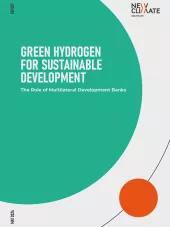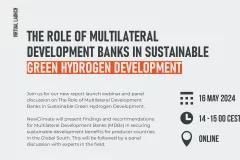While sustainable development and global equity are at the core of the Paris Agreement, inequalities between wealthy and poor countries, as well as among individuals within countries continue to increase. The impacts of inequality are starkly evident in the energy transition, where countries have unequal access to modern energy and varying speeds of renewable energy buildout. Inequality poses a challenge to achieving the goals of the Paris Agreement justly. A Paris-compatible transition must counter this reality and ensure the equitable participation of all in a zero-emission future.
To meet the goals of the Paris Agreement, strong shifts in the energy sectors are essential. Fossil fuel production and consumption need to phase out. This means that fossil fuel infrastructure needs to be decommissioned, often before its technical lifetime, and alternative revenue and energy sources developed. Fossil fuel-exporting developing countries will need to find alternative sources of income. At the same time, access to modern energy still needs to be provided and enhanced in many countries to support livelihoods and economic development. In this context, building economic resilience and forming an equitable transition that positively impacts development is a core challenge that development finance institutions can support.
Green hydrogen is emerging as a climate change and sustainable development opportunity and pushed strongly by some countries in the Global North and South. While green hydrogen is in its nascency, it offers a potentially lucrative opportunity for resource-rich countries and a decarbonisation solution for industrialised countries.
This report intends to serve as a starting point to guide public development finance institutions (DFIs), particularly multilateral development banks (MDBs), and policymakers in defining priorities related to green hydrogen. It investigates under which conditions and to what extent green hydrogen can support domestic and global decarbonisation efforts while serving development objectives. The report establishes principles for investments in sustainable green hydrogen production, addressing two dimensions: sustainable development and decarbonisation of the energy system.
Key recommendations are:
- Build up renewable energy infrastructure: Energy demand is drastically increasing in developing countries, and electricity supply must be improved for reliable and affordable access to services. The production of green hydrogen requires additional renewable electricity. At the same time, the 1.5°C limit requires fast decarbonisation of the power sector. To fully benefit from the uptake of renewable energy technologies, it is critical that developing countries can participate in the supply chain of those technologies, rather than purely rely on imports of the technologies and international expertise to construct and maintain the installations. International cooperation and finance can help increase the local content for renewable energy, through enabling access to technologies and building up local supply chains. Defining how this can best done on a case-by-case basis, and how the integration in local supply chains could be financed should be a priority.
-
Integrate electrolysers and additional RE capacities in national grids where possible. Electrolysers can technically be run at times when RE supply exceeds electricity demand, and hydrogen turbines in combination with storage can be used as a tool to balance variable renewables. Planning additional RE capacities, demand side management, electrolysers and grid connections jointly to facilitate a high share of renewables in the grid can support the energy transition in the country and enhance electrification and local energy access. The production of green hydrogen would be an additional effect. Compared to an isolated electrolyser and RE system without grid connect, the full load hours of the electrolysers would decrease, and with it the return on investment. International finance could fill this gap in income compared to a profit-optimised electrolyser for the benefit of an efficient overall system and development goals.
-
Make domestic green hydrogen available for industrial development in the Global South. In countries where industrialisation is prioritised in development strategies, or where hard-to-abate industries already exist (e.g., steel or fertiliser production or mining with heavy-duty transport needs), the use of green hydrogen will be critical for international competitiveness. In the light of emerging carbon border adjustment mechanisms, industrial goods produced via zero-emissions processes will have a competitive advantage over high-emissive production. The availability of green hydrogen will be essential for producing countries and should be prioritised over exports. Development finance providers should work with the countries to understand potential domestic hydrogen demand and prioritise this before exports.
-
Export green hydrogen to other countries. Where a country can produce green hydrogen that is competitive on a global market, the export of the fuel can generate income, diversify export structures and support the decarbonisation of importing countries. However, future trade of green hydrogen should avoid reproducing dependencies on energy resource rents, and both potential importers and exporters of green hydrogen should develop a realistic understanding of the possible volumes of trade, where today we observe a tendency towards overestimating possible flows. Importing countries will need robust policies to ensure the sustainability of green hydrogen, covering positive impacts on both the development objectives and the decarbonisation efforts of the country of origin. Countries might also strategically use exports in the near future to incentivise the development of production capacities, even at times where green hydrogen is not yet competitive domestically, with the objective to later expand the production to cover the emerging domestic demand. For potentially importing countries to support this development, this would mean equitable agreements with the exporters that allow a shift towards domestic production once needed.
Our case studies on Namibia, India, and Colombia find: the countries are at different stages in their development of green hydrogen strategies and adjacent policy support:
- Standards for hydrogen production and definitions of green hydrogen vary: India specifies that production-related emissions should be lower than 2 kgCO2/kgH2. India also considers biomass-based hydrogen to be green, without setting sustainability standards for the type of biomass used in production. Colombia, on the other hand, intends to produce both green and blue hydrogen until production of the former becomes fully competitive and naturally displaces the latter’s market share. Namibia has not clarified its definition of green hydrogen. Current projects to produce hydrogen there are off-grid, while the country continues to import emissions-intensive electricity to supply other demands.
- The countries have different visions for future hydrogen applications, not all of which are efficient: India and Colombia plan for green hydrogen to substitute the current demand for grey hydrogen in oil refining for much longer than can be considered Paris-aligned. India and Colombia are also considering a role for green hydrogen fuel cells for decarbonising transport sectors like roads and railways which can be directly electrified more efficiently.
- The countries plan to leverage their comparative advantage and capitalise on the green hydrogen export opportunity, but details vary on how production will support decarbonise within their own borders or how it will contribute to local value creation. India puts a strong focus on this aspect and subsidises domestic manufacturing of the equipment.
- The countries face significant environmental and social risks associated with domestic green hydrogen production, such as water scarcity and land availability which is a large issue in India already today.
The report and case studies will be complemented by a third deliverable in early 2024 which will delve into the role of Multilateral Development Banks (MDBs) in scaling green hydrogen and how they can integrate sustainability criteria into their existing processes.








